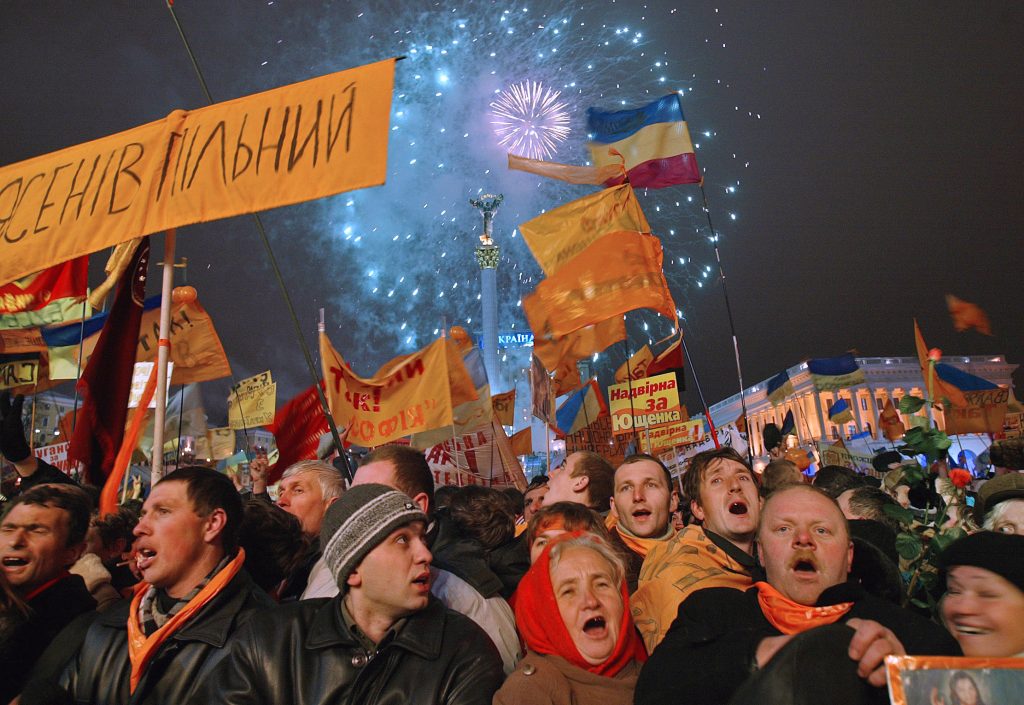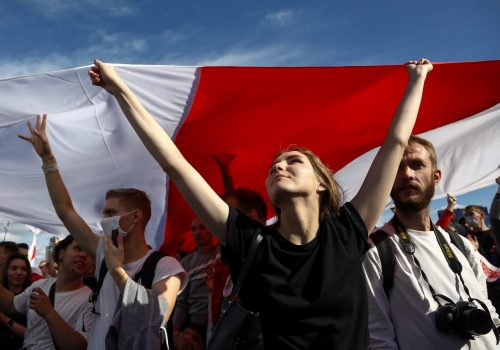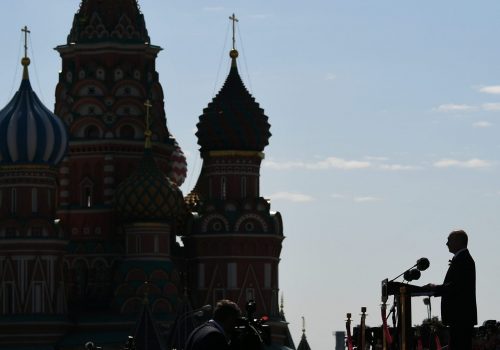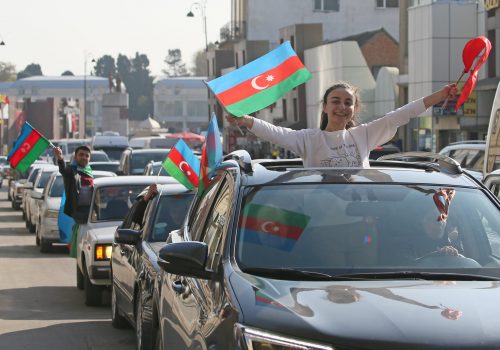Ukrainians marked the Day of Dignity and Freedom on November 21, continuing a seven-year tradition that seeks to place the country’s 2004 Orange Revolution and the 2014 Euromaidan Revolution in a broader historical context. This might also be something for the international community to consider. While Ukraine’s two people power uprisings are recognized as important milestones in the country’s post-Soviet journey, their impact on the wider region has yet to be fully appreciated.
This lack of clarity is perhaps understandable. Indeed, few events in modern European history have been subject to quite so much deliberate distortion. Ever since the Euromaidan protest movement first emerged in Kyiv in late November 2013, it has been a favored target of Russian information warfare. For the past seven years, Moscow has promoted false narratives about the uprising in order to undermine its pro-democracy credentials and justify the subsequent Russian invasion of Crimea and eastern Ukraine.
While the legacy of the Euromaidan Revolution has been buried under an avalanche of Kremlin disinformation, the earlier Orange Revolution has been increasingly forgotten. At first glance, the peaceful protests of winter 2004 appear to lack the geopolitical drama of the events which were to unfold one decade later. However, this is deceptive. While independent Ukraine’s first great people power revolution did not lead directly to Russian military aggression or spark any immediate shifts in the European balance of power, it remains a watershed moment that marked the end of the early post-Soviet era and set the stage for the Cold War climate that defines today’s international relations.
To appreciate the significance of the Orange Revolution, it is important to look beyond the political failures that followed the uprising. The protests of late 2004 initially succeeded in preventing Kremlin-backed candidate Viktor Yanukovych from stealing the Ukrainian presidency and made possible the election of his reformist rival, Viktor Yushchenko. However, Yushchenko soon found himself beset by infighting and was unable to lead Ukraine decisively towards Euro-Atlantic integration during what proved to be a hugely frustrating five-year term in office. This paved the way for Yanukovych to mount an unlikely comeback and win the 2010 presidential election race.
Nevertheless, the Ukraine of 2010 was a very different proposition to the country Yanukovych had first sought to rule six years earlier. Thanks to the Orange Revolution, Ukraine’s media landscape was no longer subject to the kind of smothering government censorship that had existed prior to 2004. In its place was a lively if imperfect form of journalistic freedom that reflected the competing interests of the country’s various oligarch clans. Once he became president, Yanukovych was unable to put the genie of a free press back into the bottle. Instead, his attempts to reverse the gains of the Orange Revolution helped spark the 2014 uprising that led directly to his downfall.
The Orange Revolution also had a profound effect on the way Ukrainians perceived themselves and their national identity. For the first thirteen years of independence, the political, cultural, social, and economic boundaries between Ukraine and Russia had remained blurred. Most people on both sides of the border continued to regard the fates of the two notionally separate countries as inextricably intertwined. This changed dramatically in 2004 when millions of Ukrainians mobilized in defense of free elections.
The protests served as a national awakening, establishing Ukraine’s democratic credentials and setting the country on a path that diverged sharply from the increasing authoritarianism of Vladimir Putin’s Russia. In the sixteen years since the Orange Revolution, Ukraine has staged eight national votes without ever witnessing a return to the kind of political oppression and rampant vote-rigging that remains routine elsewhere in the former USSR. This success has helped strengthen notions of European identity among Ukrainians and deepened the sense of psychological separation from authoritarian Russia.
Stay updated
As the world watches the Russian invasion of Ukraine unfold, UkraineAlert delivers the best Atlantic Council expert insight and analysis on Ukraine twice a week directly to your inbox.
Given Ukraine’s vast size and strategic importance, these changes alone should be sufficient to secure the Orange Revolution’s place in the wider history of Eastern Europe. However, in order to appreciate the true geopolitical impact of post-Soviet Ukraine’s big democratic breakthrough, it must be viewed in the context of Russia’s reaction.
On the eve of Ukraine’s fateful 2004 presidential election, Russian President Vladimir Putin was so confident of his ability to influence the outcome that he actually traveled to Kyiv and lectured Ukrainians on the need to back his chosen candidate. It was to prove a spectacular miscalculation, arousing indignation among many previously apolitical Ukrainians who sensed their country’s newfound independence was under threat.
Within weeks of Putin’s ill-judged visit, the Orange Revolution was underway.
The Kremlin’s initial response to events in Kyiv was a mixture of indignation and disbelief. As the scale of the disaster became apparent, the mood turned to bitterness over Ukrainian treachery and anger at what was seen as a grave betrayal on the part of Russia’s European and North American partners. Moscow regarded the West’s vocal support for the pro-democracy protests in Ukraine as nothing less than an act of international aggression. As far as the Kremlin was concerned, this was a direct attempt to interfere in Russia’s internal affairs and confirmation of the Western world’s implacable hostility.
The implications for Russian foreign policy were to prove far-reaching. During the first four years of his presidency, Putin had sought to expand cooperation with the West, albeit while also seeking to reestablish Russia’s position among the world’s leading powers. The Orange Revolution brought this era of often awkward entente to an abrupt end. In the aftermath of the revolution, Russia adopted a strikingly nationalistic course in domestic affairs, while becoming increasingly confrontational on the global stage.
One of the earliest signals of this change came in the information sphere. Within months of Ukraine’s democratic uprising, Moscow unveiled plans to launch the Russia Today TV channel. The Kremlin’s decision to enter the world of English-language international TV news broadcasting was widely interpreted as a direct response to Russia’s resounding defeat in the information war that had raged around recent events in Ukraine. By the end of 2005, Russia Today was on the air and reaching audiences around the world. The channel soon became a bastion of anti-Western messaging that allowed Russia to express its open hostility towards the post-1991 international order.
Inside Russia, the Orange Revolution occasioned a sharp change in mood as Moscow sought to make sure the sudden outbreak of democracy in Ukraine did not prove contagious. This expressed itself in a curiously defiant form of state-sanctioned nationalism which embraced a sense of continuity with the Soviet past while downplaying the crimes of the Communist era.
Weeks after the Ukrainian uprising, the Kremlin launched a nationwide campaign encouraging Russians to display orange-and-black St. George’s ribbons in honor of the Soviet victory over Nazi Germany. With images of rebellious Ukrainians sporting orange ribbons still fresh in everyone’s minds, the loyalist symbolism of this jingoistic counter-gesture was hard to miss. It also proved to be a taste of things to come. Since first appearing in spring 2005, St. George’s ribbons have established themselves at the heart of an increasingly fanatical victory cult as the Putin regime has sought to justify its own authoritarianism via ever more extravagant forms of WWII reverence. What began life as a reaction to the orange ribbons of Ukraine’s revolution has become the ultimate symbol of the entire Putin era.
At around the same time, Russia began cracking down on potential sources of domestic opposition. Having noted the involvement of Ukraine’s civil society in the grassroots activism that made the Orange Revolution possible, the Kremlin started pressuring Russian NGOs with international ties and labeling them as “foreign agents.”
With Ukrainian students also playing an important role in the revolution, the Kremlin urgently sought ways to bind young Russians more closely to the regime. This resulted in the creation of Nashi, a pro-Putin youth movement that was formed in April 2005 and enjoyed close ties to the Russian establishment. Within two years, Nashi claimed to have recruited over 100,000 members and had drawn unflattering comparisons with the Soviet-era Komsomol and the Hitler Youth.
Eurasia Center events

It took a little longer for Moscow to demonstrate its dissatisfaction on the international stage. Putin did not give full voice to the changing tone in Russian foreign policy until two years after the Orange Revolution, when he articulated his opposition to American dominance in a famous February 2007 speech to the Munich Security Conference.
From that point onward, Russian acts of international aggression would grow progressively bolder. Months after Putin’s Munich speech, Moscow launched a cyber and information attack on nearby Estonia that served as an early introduction to the Kremlin’s hybrid warfare tactics. In summer 2008, Russian tanks rolled into Georgia. Six years later, the target was Ukraine. Ever since the 2014 invasion of Ukraine, Russia and the Western world have been locked in a confrontation that many regard as a new Cold War.
There was nothing inevitable about any of this. Putin’s commitment to restoring Russia’s great power status was always likely to fuel an increase in international tensions, but it did not necessarily have to result in today’s climate of hybrid hostilities. The point of departure in this deteriorating relationship between Russia and the West was the 2004 Orange Revolution, which set the tone for everything that has since transpired. Indeed, it is no accident that while Moscow’s own actions have grown more and more belligerent, the Kremlin has continued to accuse Western countries of plotting a so-called “color revolution” inside Russia. Even the term itself is a backhanded compliment that hints at the enduring influence of Ukraine’s Orange Revolution on Russian policy-making.
For the past sixteen years, Russia has been haunted by the prospect of its own Orange Revolution and has gone to extraordinary lengths to prevent people power movements from gaining any momentum in the region. This was a key factor behind the decision to attack Ukraine in the immediate aftermath of the 2014 Euromaidan Revolution, and it is the main reason why Russia is currently backing dictator Alyaksandr Lukashenka in his struggle to suppress a pro-democracy uprising in neighboring Belarus. Moscow’s readiness to accept the extremely high foreign policy costs of these interventions is an indication of the importance Russia attaches to protecting Putin from popular protest.
Without the Orange Revolution, it is entirely plausible that the recent history of Eastern Europe would have followed a completely different trajectory. In this alternative reality, Ukraine might well have remained within Russia’s exclusive sphere of influence, allowing Putin to gradually consolidate his hold over the former Soviet Union. In time, the Kremlin would have found itself once more in control of a powerful authoritarian empire capable of rivaling the economic might of the democratic world. Knowing what we do about Putin’s revisionist attitude towards the outcome of the original Cold War, there is every reason to believe he would have used this greatly enhanced position to mount a geopolitical challenge far more comprehensive in scope that today’s spoiling tactics.
The fact that this didn’t happen is down to the millions of ordinary Ukrainians who took to the streets in November 2004 and demanded to be heard. Their courage has long since been forgotten, but the uprising they led has left its mark on the wider world and been instrumental in shaping today’s escalating showdown between Russia and the West. As the archetypal “color revolution,” Ukraine’s 2004 Orange Revolution lives on in the nightmares of the Russian elite and deserves far more recognition as one of the great geopolitical turning points of the early twenty-first century.
Peter Dickinson is the Editor of the Atlantic Council’s UkraineAlert Service.
Further reading
The views expressed in UkraineAlert are solely those of the authors and do not necessarily reflect the views of the Atlantic Council, its staff, or its supporters.

The Eurasia Center’s mission is to enhance transatlantic cooperation in promoting stability, democratic values and prosperity in Eurasia, from Eastern Europe and Turkey in the West to the Caucasus, Russia and Central Asia in the East.
Follow us on social media
and support our work
Image: Ukrainians pictured on Independence Square in central Kyiv during the country's 2004 Orange Revolution. (REUTERS/Laszlo Balogh)




